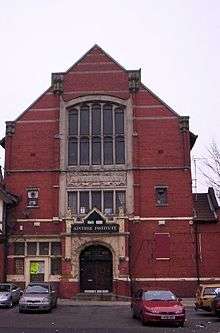Aintree Institute
The Aintree Institute was a live music venue in Walton, Liverpool, England. From the late 1950s, the venue was associated with Liverpool's growing Merseybeat scene.[1]
 The Institute in 2006 | |

| |
| Location | Walton, Liverpool, England |
|---|---|
| Type | Live music |
| Genre(s) | Beat, Rock 'n' roll, Rock |
History
The institute was founded in the 1890s by Sir William Pickles Hartley. In an initial meeting in 1892, Hartley offered £1,000 (approximately £60,000 in 2005[2]) towards a project that would see "all the Churches, from the Roman Catholic Church and the Church of England down to the very smallest mission room ... enter into a Christlike compact to fight against evil in every form."[3] After the institute's establishment, the hall was used by the Aintree Photographic Society as a club house and exhibition venue.[4]
During the Second World War, black people were prohibited from entering the hall. This was the result of a shooting and stabbing incident involving drunken black GIs.[5]
In the early 1960s, promoter Bill Kelly (also of Lathom Hall) hosted concerts at the Institute billed as "sensational jive dances". The Beatles headlined a number of these evenings, billed as "The Dynamic Beatles"[6] or the "Great Boppin' Beatles".[7] The Beatles performed a total of 31 shows at the venue[8][9] between 7 January 1961[8] and 27 January 1962.[10] While at the club, it was common for some concertgoers to throw chairs at each other and at the band. The Beatles' final concert at the venue paid £15 (approximately £230 in 2005[2]), but Brian Epstein was furious when Kelly paid the group in loose change. Epstein felt this was an insult to the band, and never booked the band with Kelly again.[10]
The Aintree was demolished in 2007.
References
- Miles, Barry (1997). Paul McCartney: Many Years from Now. London: Secker & Warburg. p. 79. ISBN 0-7493-8658-4.
- Calculated using The National Archives' Currency Converter
- Peake, Arthur S. "The Life of Sir William Hartley". Hodder and Stoughton. Retrieved 18 September 2011.
- Crookes, William (1896). The Photographic News for Amateur Photographers. 40. London: Cassell, Petter, and Galpin. p. 661.
- Reynolds, David (1995). Rich Relations: The American Occupation of Britain, 1942–1945. New York City: Random House. p. 312. ISBN 0-679-42161-0.
- Avery, Chazz. "19 August 1961 – Saturday". Photos of the Beatles, 1950s–1963. The Beatle Source. Retrieved 18 September 2011.
- Harry, Bill. "The Birth of Mersey Beat". Mersey Beat. Retrieved 18 September 2011.
- Lewisohn, Mark (2000). The Complete Beatles Chronicle. London: Hamlyn. p. 38. ISBN 0-600-60033-5.
- Gass, Glenn. "Liverpool: Beatle Clubs, Pubs and Concert Venues". The Beatles' England. Indiana University Jacobs School of Music. Retrieved 18 September 2011.
- Lewisohn, Mark (2000). The Complete Beatles Chronicle. London: Hamlyn. p. 64. ISBN 0-600-60033-5.